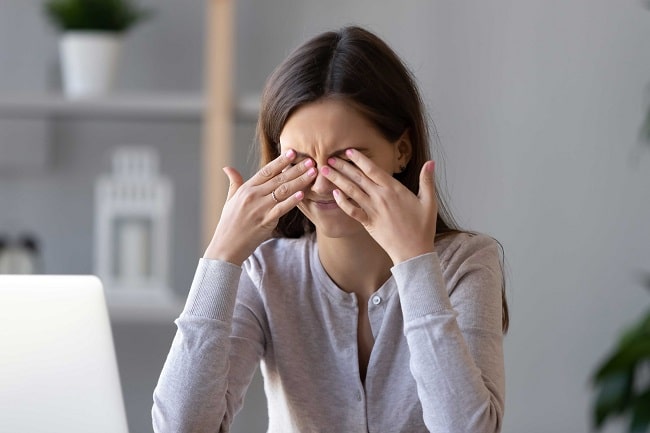
Dry Eye & Dry Eye Syndrome
What is Dry Eye?
Dry eye means that your eyes may not be making enough tears, that the tears which are being produced are of poor quality or that the tears that are produced evaporate away. The normal function of tears is to keep the surface of the eye wet and lubricated so any shortage of tears or reduction in their quality can produce a gritty, burning sensation of the eyes and can also disturb vision.
The symptoms of dry eye syndrome may include
- Dryness
- Burning, stinging or itching
- Gritty feeling
- Irritation from wind or smoke
- Blurred or smeary vision
- Tired eyes
- Red eyes
- Excessive watering
- Photophobia (sensitivity to light)
- Contact lens discomfort

What are the causes of Dry Eye?
Dry eye can be caused by a wide variety of everyday factors and include:
- Aging
- Blepharitis
- Dry environment and pollution
- Computer use
- Contact lens wear
- LASIK surgery
- Preservatives
- Hormonal changes, especially in women e.g. menopause
Dry eye may also be symptomatic of general health problems or disease e.g. people with arthritis are more prone to dry eye (Sjogren’s Syndrome = arthritis + dry eye + dry mouth) Certain types of medications (anti-acne, some beta-blockers, oral contraceptives, antihistamines, diuretics, decongestants, alcohol & anti-depressants…) CAUTION: do not alter or adjust your prescribed medicines without discussing with your Doctor). Your optometrist or Doctor can advise of any known links between medicines and dry eye.
How is Dry Eye treated?
In some cases patient’s symptoms can be relieved simply by altering the external influences above. Environmental factors can be helped by making simple changes – for example avoidance of dehydrating environments such as air conditioning; if your job involves lots of computer work take regular breaks to rest your eyes. Protecting the eye from dehydrating influences such as a cold wind by wearing spectacles or sunglasses may also help. Tears must be distributed efficiently, replaced or conserved in order to provide relief. As dry eye syndrome is caused by an imbalance of tears on the eye’s surface the most logical way to treat the problem is to artificially replace the tears and by so doing improve both quantity and quality. Even a watery eye can be caused by the tears evaporating. This results in dry patches which the eye tries to correct by a flood of watery tears. Sometimes too much tear flow just needs better lubrication; think of a car engine with water in it, it will be wet but will not be well lubricated. There are a variety of artificial tears available and you will be advised the best option for your particular problem and how to use your treatment. In severe cases of dry eye punctum plugging is available, where tiny little plugs are put into the tear ducts to prevent the tears draining away.
Hyabak® :
- Patient Friendly Bottle
- Extremely easy to administer drops
- Handy size to fit in any bag or pocket
- Suitable for regular use
- Economical
- No wastage
- Can be used until the very last drop
- Can be used up to 8 weeks after opening
- Suitable for all contact lens wearers
- Every drop provides a sufficient and precise dose
- Optimal water retention – acts as a sponge, retaining water and releasing it progressively
- “Intelligent” drops that flow when you blink and retain a clear surface when your eye is still
- Preservative Free
Thealoz®
- A new approach to Dry Eye Management
- Thealoz® is a new concept in Dry Eye management that comes from nature. It has a novel mode of action which may enable trehalose to address different causes of dryness.
- Trehalose – we learn from watching nature
- Thealoz® contains trehalose – a unique natural disaccharide that is known to improve cell water management, avoid cell membrane lipid oxidation and protein denaturation and to preserve epithelial cell life in dry conditions.
- Thealoz® works by protecting the cells of the cornea and conjunctiva and giving resistance to dryness.

